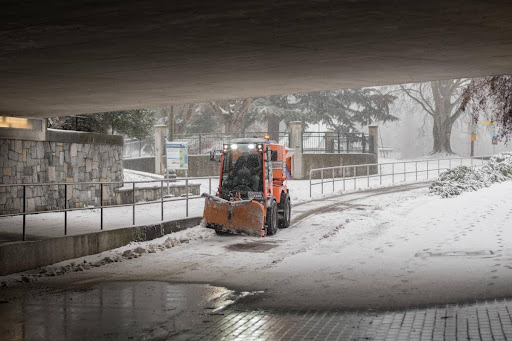
Winter in the Denver metro area and Front Range can be brutal, leading to significant challenges for commercial property owners. Safety is the top priority for any commercial property, which is why a well-executed snow management plan is essential in order to control risk and reduce liability exposure. The keys to a well-executed snow management plan are strategies and methods that emphasize preparation and efficiency.
In this article we will provide you with valuable strategies that will ensure your commercial property remains safe during even the roughest winter weather:
7 Strategies for Efficient and Effective Snow Removal
Create a Comprehensive Snow Management Plan
Developing a solid snow management plan is the key to efficient snow removal. It’s important to assess the property’s layout and understand traffic flow (both pedestrian and vehicular) in order to designate priority areas for clearing. An effective snow management plan ensures that everyone is on the same page when it comes to proper procedures and how resources are best used during a snow event.
Proactive Measures: Prevent Snow and Ice Accumulation
The best method to prevent snow and ice accumulation is a proactive approach. Laying out deicers before snow has a chance to accumulate (also known as anti-icing) will help prevent the snow from compacting and turning into ice and also lower the freezing point of any snowmelt, preventing the formation of ice. Anti-icing is far more effective than trying to use deicers after snow and ice have begun to accumulate, which also helps cut down on material waste.
Utilize Cover for Hardscapes and Landscape Features
Another incredibly simple yet effective strategy for snow and ice management is to use covers and barriers to protect the property’s hardscapes and other features. There are several types of covers and barriers that can be used to aid in snow removal:
- Tarps are effective short-term covers that are great for keeping snow off of areas such as exterior stairs and accessibility ramps. They can also be used to cover tables, benches, and even pergolas to keep things dry.
- More permanent coverings like canopies and awnings are also effective at keeping snow and ice from areas such as building entrances, outdoor seating areas, and parking lots.
- Snow barriers are great for preventing snow from accumulating on certain areas of the property while plowing, such as flower beds, walkways, and public seating areas.
- Snow fences cause turbulence in the air, forcing snowdrifts to fall and accumulate in a desired area (i.e., keeping snow away from areas you don’t want it to accumulate). These may be effective for properties with wide open spaces around them, like large fields or empty lots where winds can pick up.
Quick and Effective Response
Responding quickly to snow events is vital to ensuring the safety and convenience of anyone accessing the property. Prioritize high-traffic areas like entrances, parking lots, and walkways so that the risk of accidents is reduced.
A timely response can also make it much easier on the body to clear snow. It’s much faster – and less physically taxing – to clear a walkway with 1 or 2 inches of snow a handful of times than it is to wait and clear 6 inches of snow (or more) one time. Clearing snow quickly also makes it easier for deicers to work effectively, as they don’t work well when snow has already accumulated.
Properly Operate and Maintain Snow Removal Equipment
Well-maintained vehicles and equipment are essential for efficient snow removal. Downtime is the mortal enemy of efficiency; issues like broken-down vehicles and damaged plows can grind progress to a halt. Regularly inspect and service all trucks, plows, blowers, spreaders, and other equipment to ensure they are in good working order.
Prioritize Safety and Proper Procedures
Safety is paramount for commercial properties when winter weather hits. Some ways that property owners can improve general safety and reduce the risk of accidents and injuries include:
- Using signage to clearly mark any areas that may present icy hazards.
- Ensuring that the property has adequate lighting
- Inspecting all stairs, ramps, and making sure handrails and guard rails are securely installed
Consider Outsourcing to a Commercial Snow Removal Contractor
One of the best ways to effectively handle snow removal is to contract a professional snow removal company. Outsourcing to a commercial snow removal contractor can have several advantages:
- Snow removal contractors have access to equipment and resources that allow them to handle large properties efficiently, as well as the expertise to use them effectively
- Outsourcing also reduces the burden of snow removal on property owners/employees, both in the physical labor sense and from a liability standpoint
- Hiring a snow removal contractor can actually save property owners money in the long run, as there is no need to purchase any snow removal equipment or pay for maintenance/repairs
Do You Need Efficient Snow Removal Services for Your Denver Commercial Property?
Snowology Brings a New Approach to the Snow Removal Industry
Built on decades of experience, Snowology was created to provide customers with efficient and effective snow management services. By incorporating The Science of Snow Removal into everything we do, we’re able to develop a snow management plan for your commercial property that emphasizes efficiency, controls risk, and reduces liability exposure.
By putting the customer first and prioritizing communication, trust, and accountability, we work to educate our customers and reduce the gap between property owners and their snow contractors. Our goal is to make sure that customers are confident that they hired the right snow removal contractor for the job.
To see what Snowology can do for your Denver area commercial property, give us a call at (720) 912-9456 or get in touch with us online to get started.
